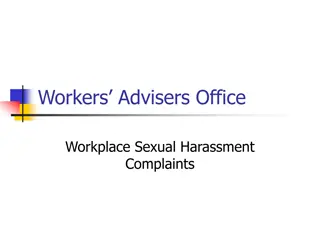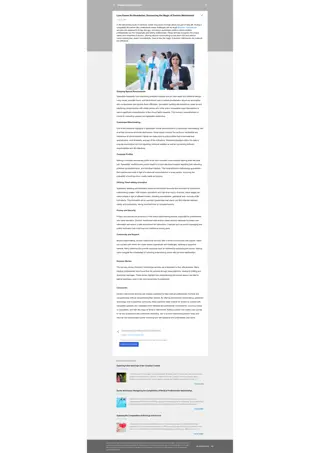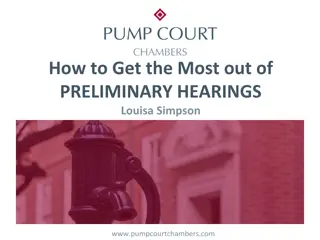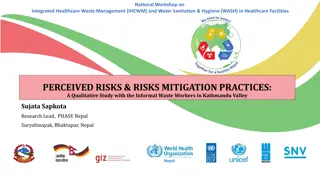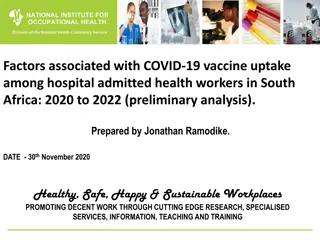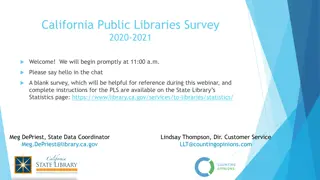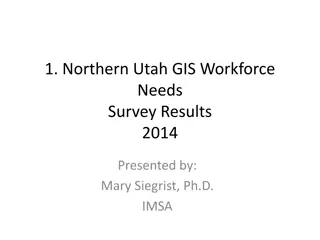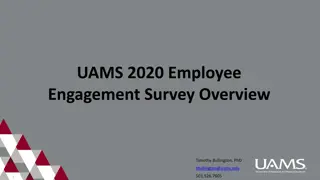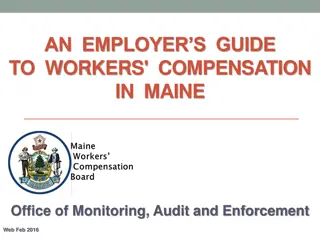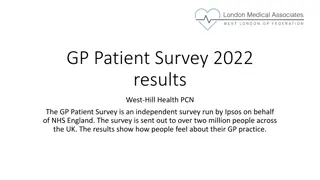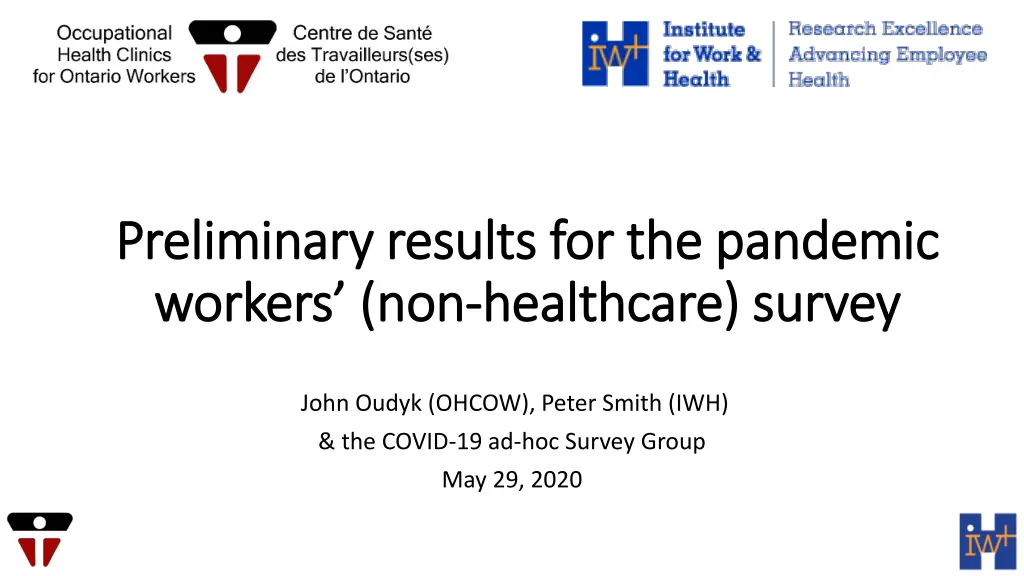
Preliminary Results and Survey Findings for Pandemic Workers' Health
Explore preliminary results and survey insights on the mental health risks faced by non-healthcare pandemic workers amidst the COVID-19 pandemic. Learn about the background of the research and the diverse members of the COVID-19 ad-hoc Survey Group involved. Discover a comprehensive survey designed to capture worker experiences during a pandemic, with specific focus on burnout, sleep symptoms, and anxiety indicators. Engage with the survey in English and French to contribute to understanding and addressing the challenges faced by workers during these unprecedented times.
Uploaded on | 0 Views
Download Presentation

Please find below an Image/Link to download the presentation.
The content on the website is provided AS IS for your information and personal use only. It may not be sold, licensed, or shared on other websites without obtaining consent from the author. If you encounter any issues during the download, it is possible that the publisher has removed the file from their server.
You are allowed to download the files provided on this website for personal or commercial use, subject to the condition that they are used lawfully. All files are the property of their respective owners.
The content on the website is provided AS IS for your information and personal use only. It may not be sold, licensed, or shared on other websites without obtaining consent from the author.
E N D
Presentation Transcript
Preliminary results for the pandemic Preliminary results for the pandemic workers (non workers (non- -healthcare) survey healthcare) survey John Oudyk (OHCOW), Peter Smith (IWH) & the COVID-19 ad-hoc Survey Group May 29, 2020
Background: Background: Invited to help with the healthcare unions in responding to draft infection control procedures from the PHO & PHAC Based on previous work done with them during SARS, 2009-nH1N1 and Ebola (also involved with PHO & MOH in organizing a summit to address infection control issues between pandemics 2014-15) Reviewing the literature coming out of China, noted a number of surveys done to characterize mental health risks to HCW s Floated the idea of doing a survey with Ontario HCW unions & the CFNU and created an ad hoc team to devise a survey
Members of Members of COVID COVID- -19 ad hoc Survey Group 19 ad hoc Survey Group: : Ontario healthcare unions H&S staff reps (ONA, SEIU, OPSEU, CUPE, Unifor, USW) Canadian Federation of Nurses Unions (CFNU) OFL, BCNU, HSABC Guy Potter, occupational psychologist with Duke University Hospital in North Carolina (COPSOQ International Network) Peter Smith, researcher with Institute for Work and Health (IWH) A variety of interested academics and activists from Canada and the US Valerie Wolfe, Daryl Stephenson & myself (OHCOW)
A Survey of A Survey of Non Experiences during a Pandemic Experiences during a Pandemic Non- -Healthcare Workers Healthcare Workers This survey was adapted from the HCW s pandemic survey by Dorothy Wigmore, Laura Lozanski, Alec Farquhar and the COVID-19 ad hoc Survey Group Similar to the HCW survey, it is designed to capture worker experiences during a pandemic. about 70 questions ( takes about 15-20 minutes to fill out) allowed respondent to create an id code so they can fill out the survey more than once (things are changing over time) in French & English (thanks to OPSEU & USW for translating, and thanks to Claude Letellier (Laval) for checking the original translation) (still) available on OHCOW s SurveyMonkey account: https://www.surveymonkey.com/r/worker_survey (EN) https://www.surveymonkey.com/r/pandemie_sondage (FR)
Survey content Survey content COPSOQ (StressAssess) scales measuring burnout and sleep symptoms (2 questions each); GAD-2 and the PHQ-2 scales to measure anxiety and depression symptoms (2 questions each); 3 questions from a German self-efficacy scale (General Self-Efficacy Short Scale (ASKU)); custom made exposure scales (PPE adequacy/availability, similar for preventive measures/procedures (P&P), and training) COPSOQ scales for quantitative demands, work pace, predictability, role conflict, supervisor support, colleague support (created a similar question for family support) StressAssess question about psychological H&S climate
Results as of May 13: Results as of May 13: 4,888 opened the survey and completed at least one question:
Percent of survey completed (N = 4,888) Percent of survey completed (N = 4,888) 500 450 3,319 respondents (68% of the sample) completed 70% or more of the survey questions 400 350 300 250 200 150 100 50 0
Number of survey responses by date Number of survey responses by date 800 728 700 600 506 503 500 400 count 295 300 238 213 200 155 140 120 119 100 66 51 46 38 37 32 29 3 0
Responses by Union (preliminary) Responses by Union (preliminary) 40% 34.9% 35% 30% 27.1% 25% frequency 20% 16.9% 15% 7.6% 10% 5.4% 3.9% 5% 1.3% 1.3% 1.0% 0.6% 0% AUPE BUFA UNIFOR CUPE OPSEU LUFA USW Other No Missing Union
Responses by Province (preliminary) Responses by Province (preliminary) 90% 77.8% 80% 70% 60% 50% frequency 40% 30% 20% 10% 4.0% 3.6% 3.3% 3.1% 3.0% 2.0% 1.2% 1.1% 0.8% 0.2% 0.1% 0% NFLD NB NS PEI QB ON MB SK AB BC other Missing
Age distribution Age distribution 35% 29.5% 30% 27.3% 23.8% 25% frequency 20% 14.0% 15% 10% 4.1% 5% 1.4% 0% 18 to 24 Years 25 to 34 years 35 to 44 years 45 to 54 years 55 to 64 years 65+ years
Current working status (number of respondents) Current working status (number of respondents) 60% 53.0% 50% 40.3% 40% 30% 20% 10% 6.7% 0% Working at home Working at workplace Not working
How much contact do you have with co How much contact do you have with co- -workers/member of the public? (respondents currently physically at work) public? (respondents currently physically at work) workers/member of the 70% 61% 58% 58% 60% Co-workers 50% 46% 45% 43% Public 40% 30% 24% 21% 20% 20% 10% 10% 0% Direct contact Within 6 feet Work in general area (more than six feet away) Visit areas where they are present/share entrances other facilities None
at the source along the path at the worker
Adequacy of infection control procedures (ICP) Adequacy of infection control procedures (ICP) 18 types 18 types Appropriate type but inadequately implemented Appropriate and adequately implemented Not sure/don t know what is appropriate Inappropriate Lacking Not applicable Type of P&P is needed Type of P&P is not needed Needs Met Needs not Met Needs not Met Needs not Met Not Applicable Infection control program; reporting procedures; training about the program and reporting; training about (new) cleaning, sanitizing and disinfection procedures; Increased ventilation; Physical barriers between you and others; isolation of people you serve; Airborne infection isolation rooms (AIIR); Place to change to/from work clothes and shoes; Staggered schedules; Physical distancing procedures from clients; Physical distancing procedures from workers; Regular cleaning; Sanitizing food preparation surfaces; Disinfecting high-touch surfaces and objects; Laundry for work clothes; Laundry for work-related materials; Waste disposal practices;
ICP needs and proportion of needs met (1). Workers at ICP needs and proportion of needs met (1). Workers at physical workplace (N = 1,636) physical workplace (N = 1,636) 738 (45%) workers with unmet need 784 (48%) workers with unmet need 100% Needed Needs met 90% 81% 77% 80% 73% 67% 70% 64% 59% 60% 48% 48% 50% 44% 42% 39% 39% 39% 40% 34% 34% 30% 25% 21% 20% 20% 10% 0% Infection Control Program Reporting procedures Training about IC and reporting Training about cleaning Increased ventilation Physical barriers Isolation of people you serve AIIRs Change facilities
ICP needs and proportion of needs met (2). Workers at ICP needs and proportion of needs met (2). Workers at physical workplace (N = 1,636) physical workplace (N = 1,636) 699 (43%) workers with unmet need 784 (53%) workers with unmet need 100% 91% 90% 88% Needed Needs met 90% 81% 80% 70% 65% 60% 60% 55% 53% 52% 50% 50% 45% 45% 44% 44% 41% 40% 40% 39% 40% 30% 20% 10% 0% Staggered schedules Physical distancing (clients) Physical distancing (co- workers) Regular cleaning Sanitizing food prep surfaces Disinfecting high touch areas Laundry for work clothes Laundry for work materials Waste disposal
Personal protective equipment (PPE) supply and adequacy Personal protective equipment (PPE) supply and adequacy Appropriate type and adequate supply Appropriate type but inadequate supply Inappropriate type, but adequate supply Inappropriate type and inadequate supply Not Needed, but not available sure/don t know what is appropriate Not applicable Type of PPE is needed Type of PPE is not needed Needs not Met Needs not Met Needs not Met Needs not Met Needs Met Not Applicable (1) Gloves; (2) Eye protection/goggles; (3) face shield; (4) gown; (5) soap and water; (6) hand sanitizer; (7) surgical masks; (8) N95 masks; (9) regular respirators (10) PAPR (powered air particulate respirators)
PPE needs and proportion of needs met. Workers at physical PPE needs and proportion of needs met. Workers at physical workplace (N = 1,667) workplace (N = 1,667) 593 (36%) workers with unmet need609 (37%) workers with unmet need 100% 94% 94% 89% Needed Needs met 90% 83% 80% 73% 69% 70% 62% 57% 56% 60% 55% 53% 49% 49% 50% 41% 39% 38% 40% 28% 30% 25% 24% 20% 12% 10% 0% Gloves Eye protection Face shield Gowns Soap and water Hand sanitizer Surgical masks N95 masks Regular respirators PAPRs
Proportion of ICP and PPE needs met. Respondents Proportion of ICP and PPE needs met. Respondents at physical workplace (N = 1,667) at physical workplace (N = 1,667) 40% ICP 35% 36% 35% PPE 30% 32% 25% 28% 27% 20% 19% 15% 18% 10% 5% 6% 0% 100% of Needs Met 50% to 99% of Needs Met 1% to 49% of Needs Met None of Needs Met
Training related to COVID Training related to COVID- -19 19 How would you rate the adequacy of your training in regards to working with COVID-19? (excellent; very good; good; neutral; not so good; poor; none at all; not applicable) Do you feel sufficiently trained to don and doff your PPE without contaminating yourself? (I have been trained and feel very confident; I have been trained and feel confident; I have been trained and feel somewhat confident; I have been trained but do not feel confident; I have not received such training)
Proportion of respondents indicating working with Proportion of respondents indicating working with COVID COVID- -19 training and PPE training was adequate 19 training and PPE training was adequate 35% 30% 30% 25% 20% 15% 16% 10% 5% 0% PPE training adequacy COVID Training adequacy
Selected health outcomes (1) Selected health outcomes (1) Generalized Anxiety Disorder 2-item (GAD-2) The following questions ask about thoughts, feelings, and behaviours, often tied to concerns about family, health, finances, school, and work over the last 7 days. Feeling nervous, anxious or on edge Not being able to stop or control worrying Patient Health Questionnaire-2 (PHQ-2) depressive symptoms Little interest or pleasure in doing things Feeling down, depressed or hopeless Response options: Not at all (0), several days (1), more than half the days (2), nearly every day (3). Scores of three and higher ( 3) standard cut point for screening for anxiety and depression.
Selected health outcomes (2) Selected health outcomes (2) Fear On a scale from 1 to 10 how would you rate your current level of fear about this whole pandemic situation? little to no fear at all = 1 2 3 4 5 6 7 8 9 10 = as much fear as I have ever felt Concern How concerned are you about bringing the virus home to those who you live and/or friends? no concern = 1, little concern, some concern, concerned, very concerned, extremely concerned = 6
Distributions (median and interquartile ranges) for selected Distributions (median and interquartile ranges) for selected mental health outcomes. Entire Sample (N = 3,319) mental health outcomes. Entire Sample (N = 3,319) 10 = as much fear as I ve ever felt 10 9 8 7 42.0% 3 6 = extremely concerned 6 6 34.2% 3 5 5 4 4 3 3 3 = optimal screening cut point 2 2 1 = little to no fear at all 1 = no concern 1 1 0 0 GAD-2 PHQ-2 Fear Concern
Adjusted proportion of respondents with GAD Adjusted proportion of respondents with GAD- -2 and PHQ scores of 3 and higher by working status (N = 3,034) scores of 3 and higher by working status (N = 3,034) 2 and PHQ- -2 2 60% Anxiety 50% Depression 48% 45% 40% 38% 38% 37% 30% 31% 20% 10% 0% Working remotely Working at physical workplace Not working * Adjusted for gender, age, visible minority status, province, population density, experiencing COVID-19 symptoms, told had contact with someone with COVID-19, and workplace size.
Adjusted proportion of respondents with Adjusted proportion of respondents with GAD and higher by working and and higher by working and ICP needs GAD- -2 scores 2 scores of three being met (N = 3,034) of three ICP needs being met (N = 3,034) 70.0% 60.0% 57.4% 50.0% 53.1% 48.7% 40.0% 38.5% 38.0% 30.0% 28.6% 20.0% 10.0% 0.0% Working remotely At work (100% needs met) At work (50% - 99% needs met) At work (1% to 49% needs met) At work (none of needs met) Not working * Adjusted for gender, age, visible minority status, province, population density, experiencing COVID-19 symptoms, told had contact with someone with COVID-19, and workplace size.
Adjusted proportion of respondents with Adjusted proportion of respondents with PHQ and higher by working and and higher by working and ICP needs PHQ- -2 scores 2 scores of three being met (N = 3,034) of three ICP needs being met (N = 3,034) 60.0% 50.0% 50.7% 44.7% 40.0% 38.3% 30.0% 31.0% 29.5% 20.0% 22.4% 10.0% 0.0% Working remotely At work (100% needs met) At work (50% - 99% needs met) At work (1% to 49% needs met) At work (none of needs met) Not working * Adjusted for gender, age, visible minority status, province, population density, experiencing COVID-19 symptoms, told had contact with someone with COVID-19, and workplace size.
Adjusted proportion of respondents with Adjusted proportion of respondents with GAD and higher by working and and higher by working and PPE needs GAD- -2 scores 2 scores of three being met (N = 3,034) of three PPE needs being met (N = 3,034) 70.0% 64.7% 60.0% 50.0% 52.1% 47.2% 47.9% 40.0% 37.9% 35.1% 30.0% 20.0% 10.0% 0.0% Working remotely At work (100% needs met) At work (50% - 99% needs met) At work (1% to 49% needs met) At work (none of needs met) Not working * Adjusted for gender, age, visible minority status, province, population density, experiencing COVID-19 symptoms, told had contact with someone with COVID-19, and workplace size.
Adjusted proportion of respondents with Adjusted proportion of respondents with PHQ and higher by working and and higher by working and PPE needs PHQ- -2 scores 2 scores of three being met (N = 3,034) of three PPE needs being met (N = 3,034) 60.0% 56.9% 50.0% 49.0% 40.0% 39.9% 35.4% 30.0% 30.6% 27.3% 20.0% 10.0% 0.0% Working remotely At work (100% needs met) At work (50% - 99% needs met) At work (1% to 49% needs met) At work (none of needs met) Not working * Adjusted for gender, age, visible minority status, province, population density, experiencing COVID-19 symptoms, told had contact with someone with COVID-19, and workplace size.
Take home messages Take home messages - there s a significant amount of stress, fear, anxiety and depression among workers not in healthcare. - The mental health experiences of workers who are physically at their workplace vary with ICP and PPE provision. - The lowest levels of anxiety and depression are observed among workers where ICP have been effectively addressed (lower than those working remotely). - The highest levels of anxiety and depression are observed among workers where ICP and PPE have not been effectively addressed (higher than those who have lost work and income).
Thank you! any questions/comments? Thank you! any questions/comments? (please use the chat box) For more information on this presentation or the survey please contact: John Oudyk: joudyk@ohcow.on.ca Peter Smith: psmith@iwh.on.ca



